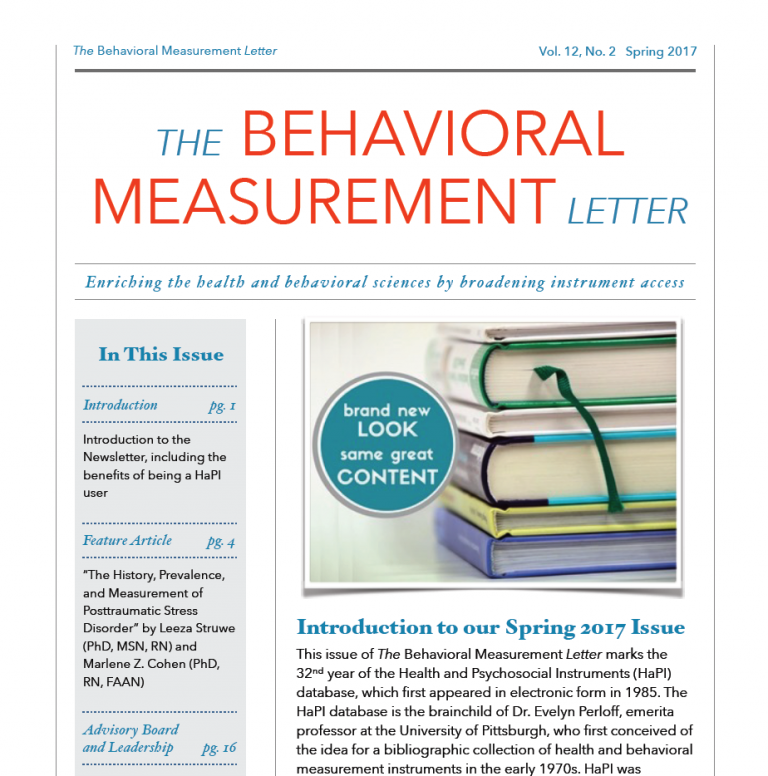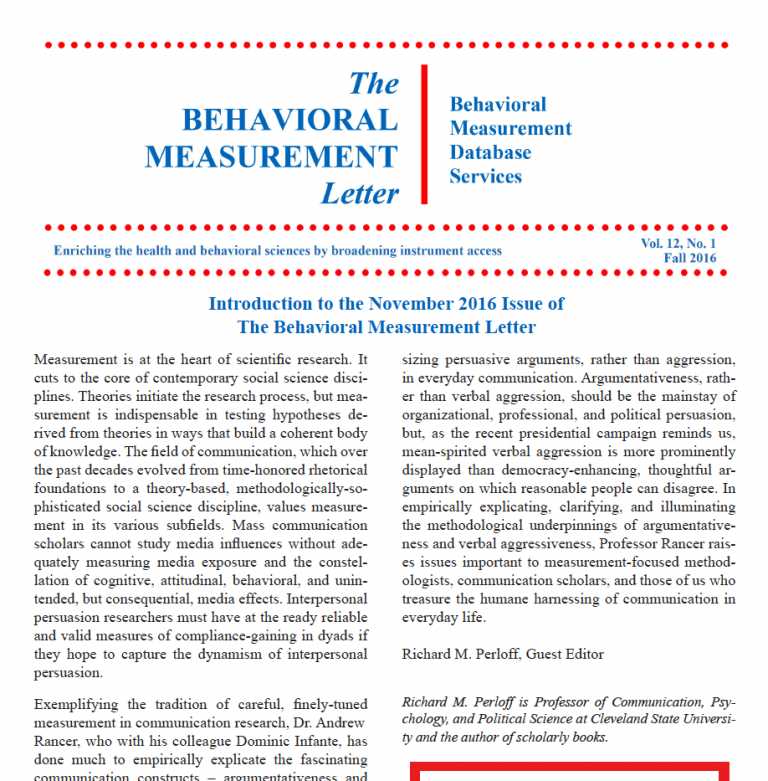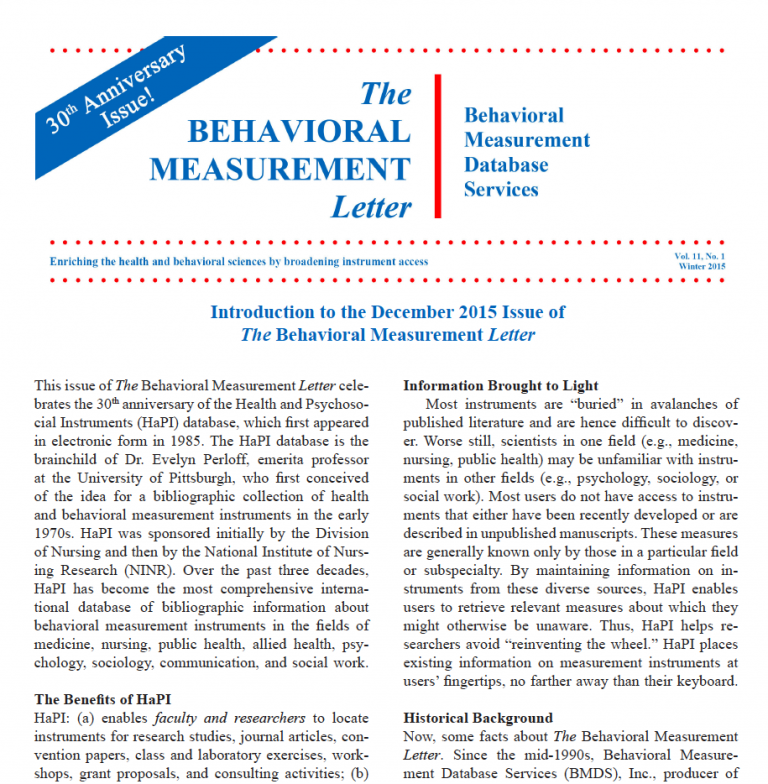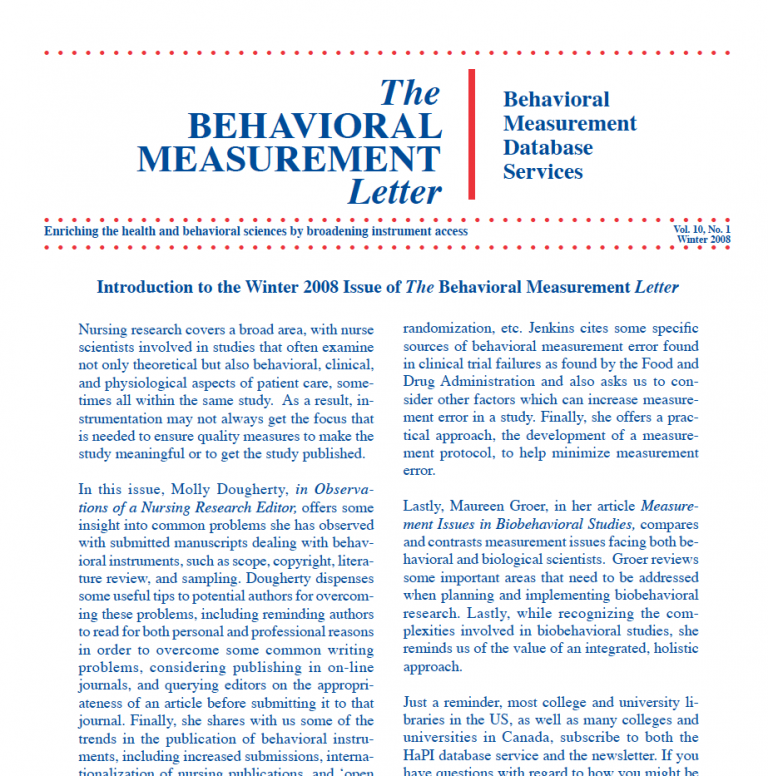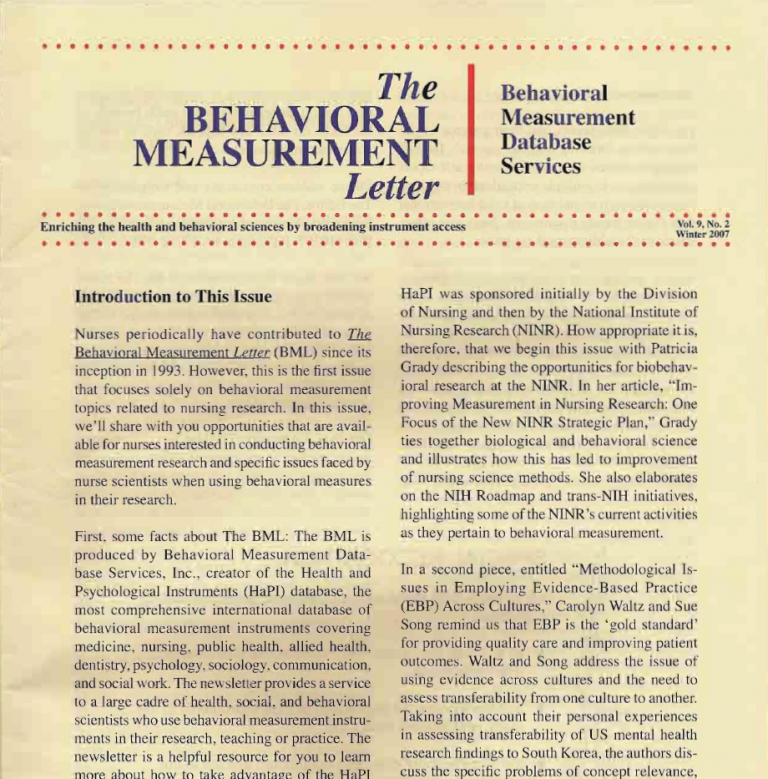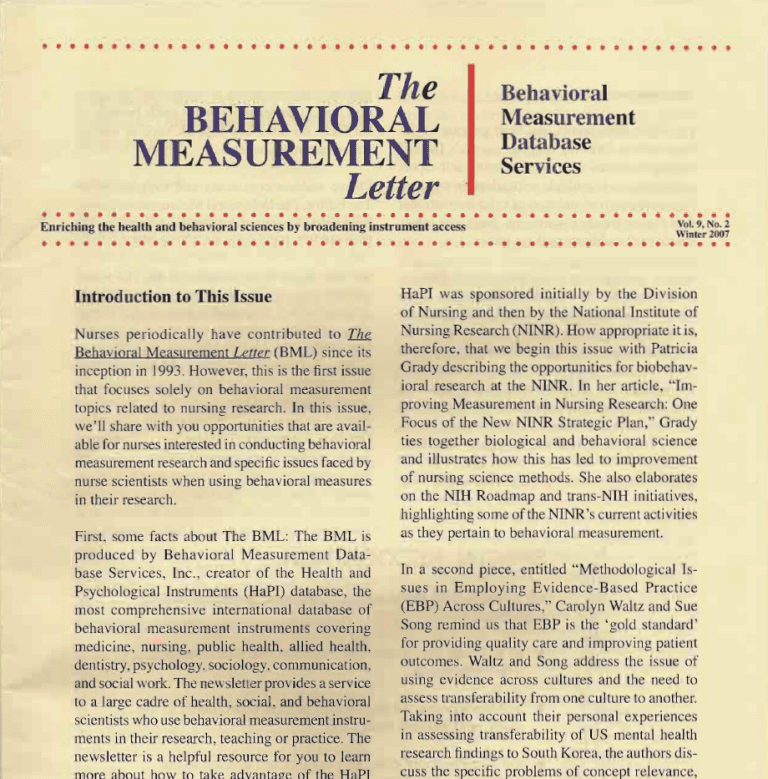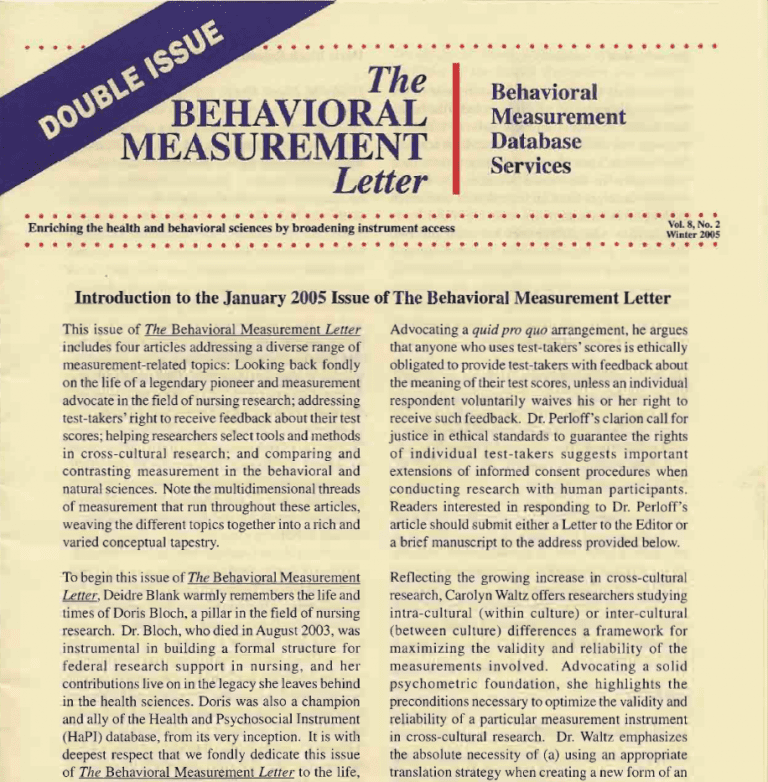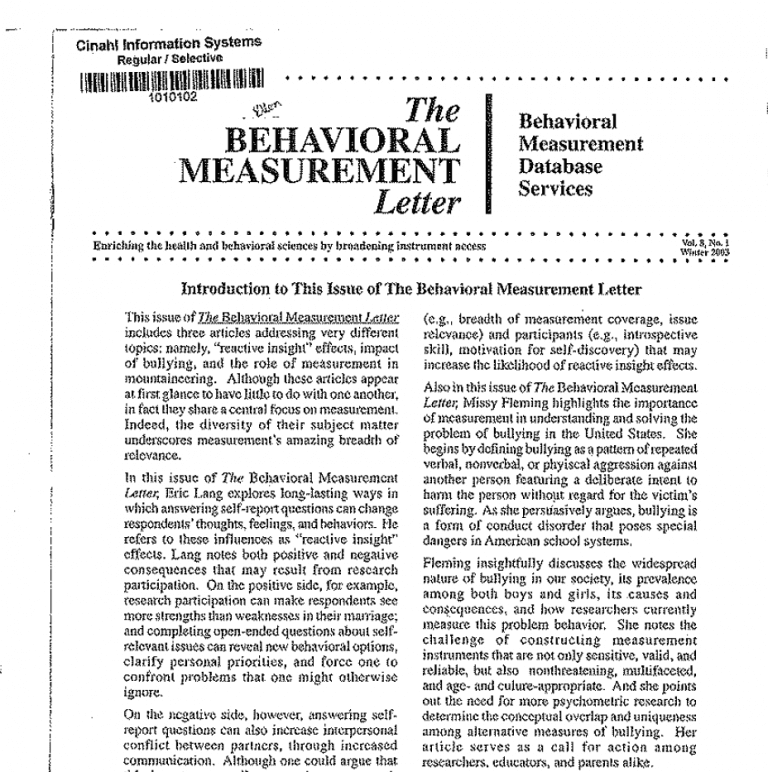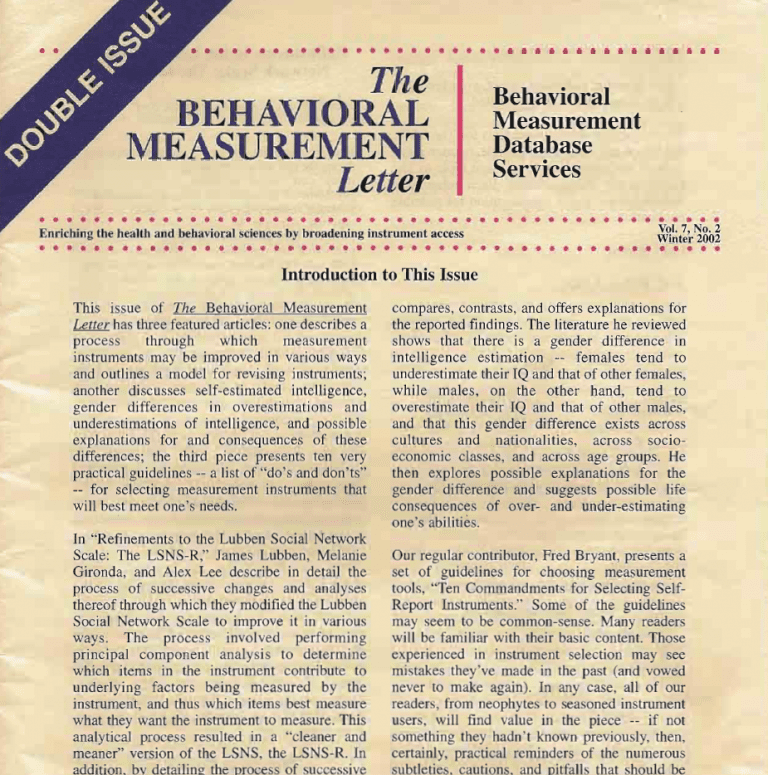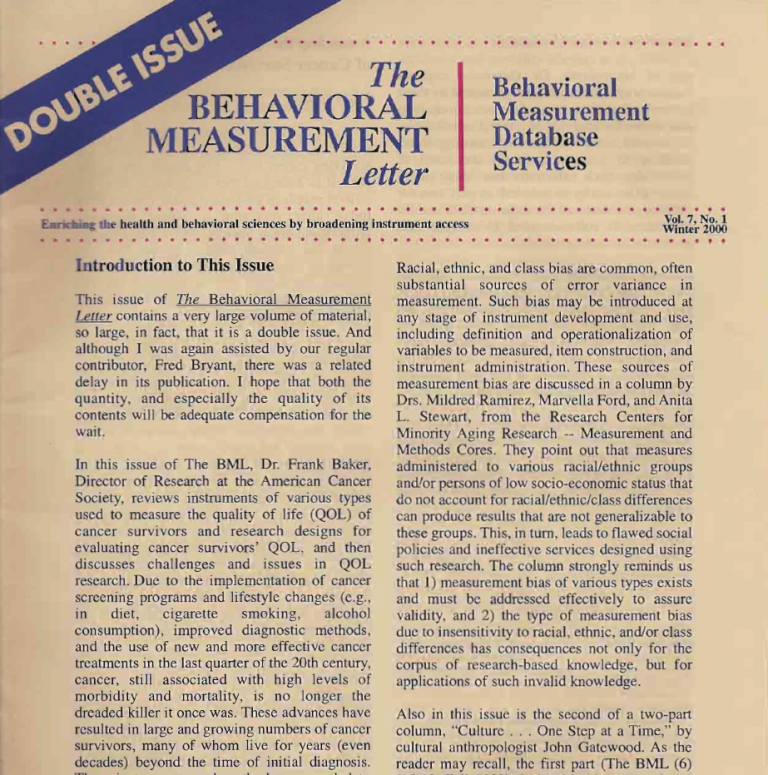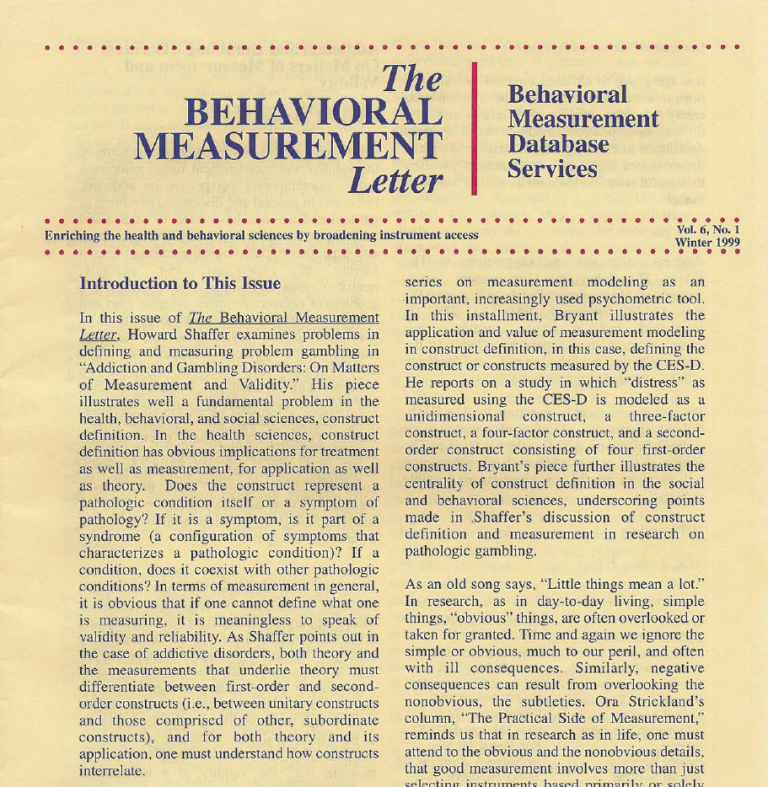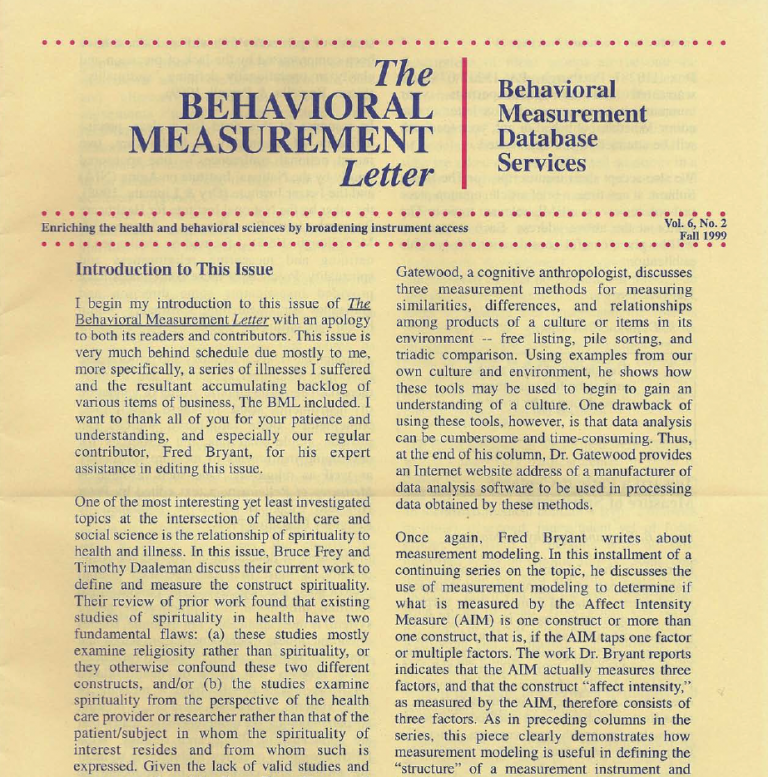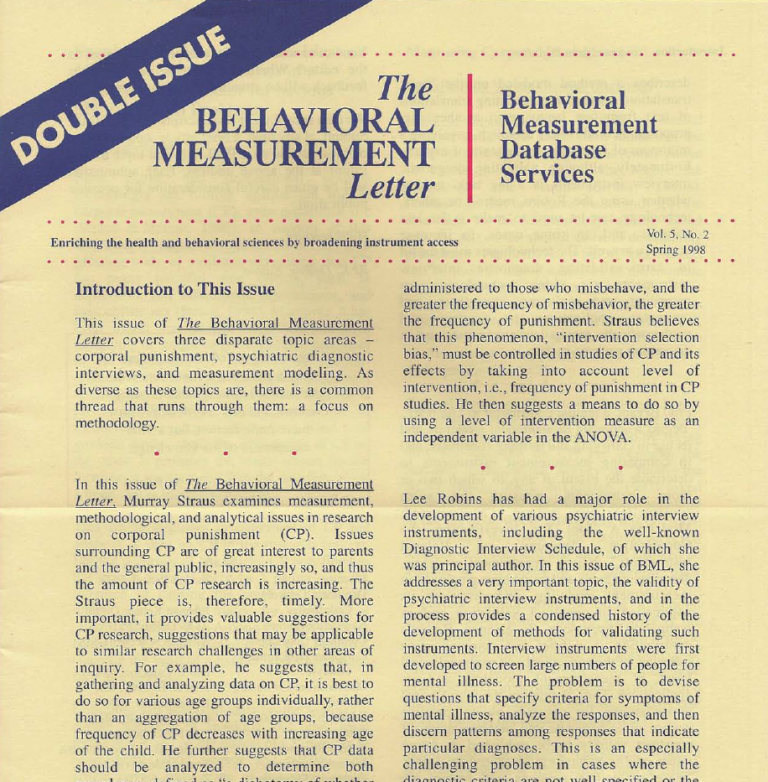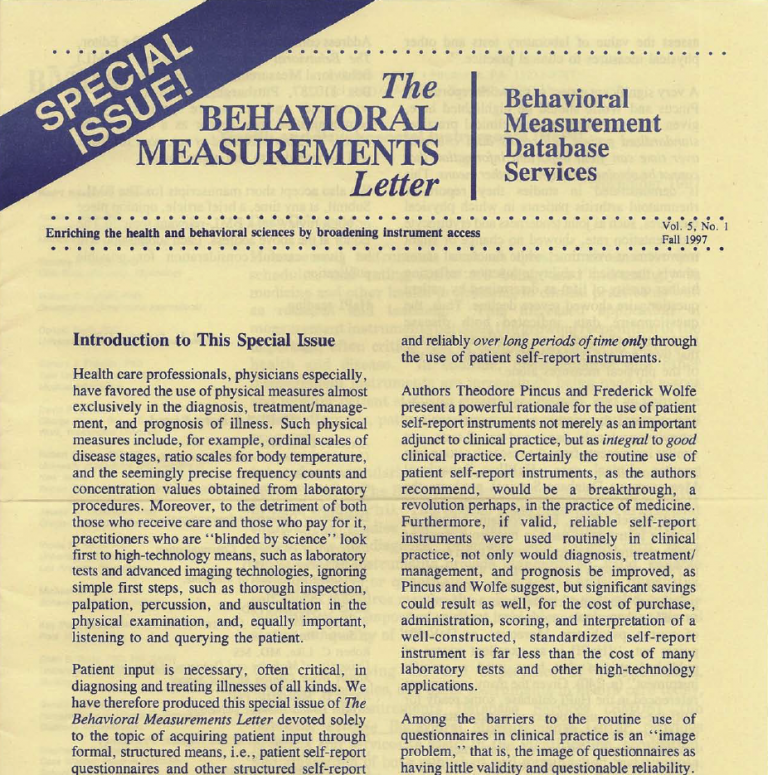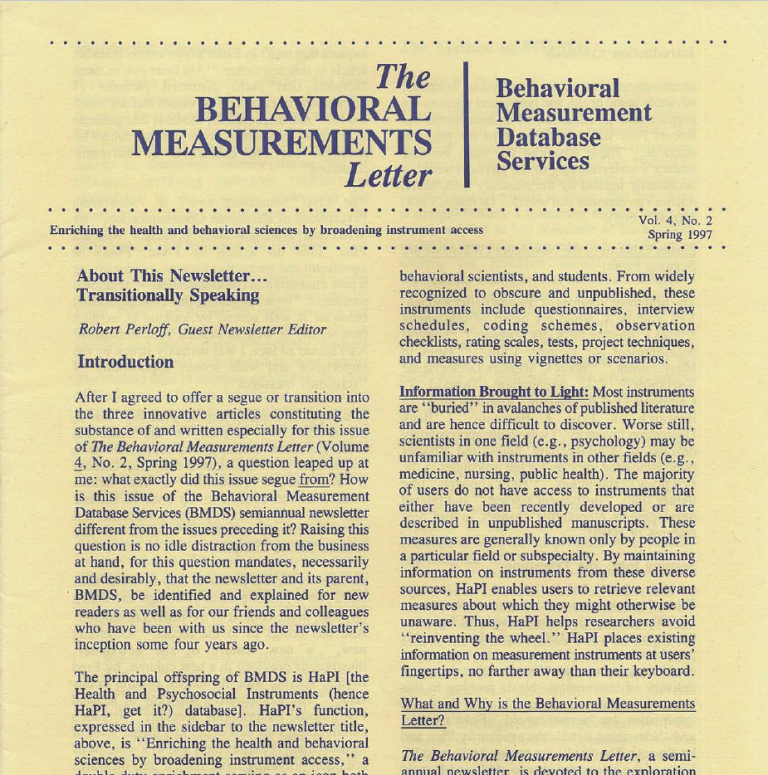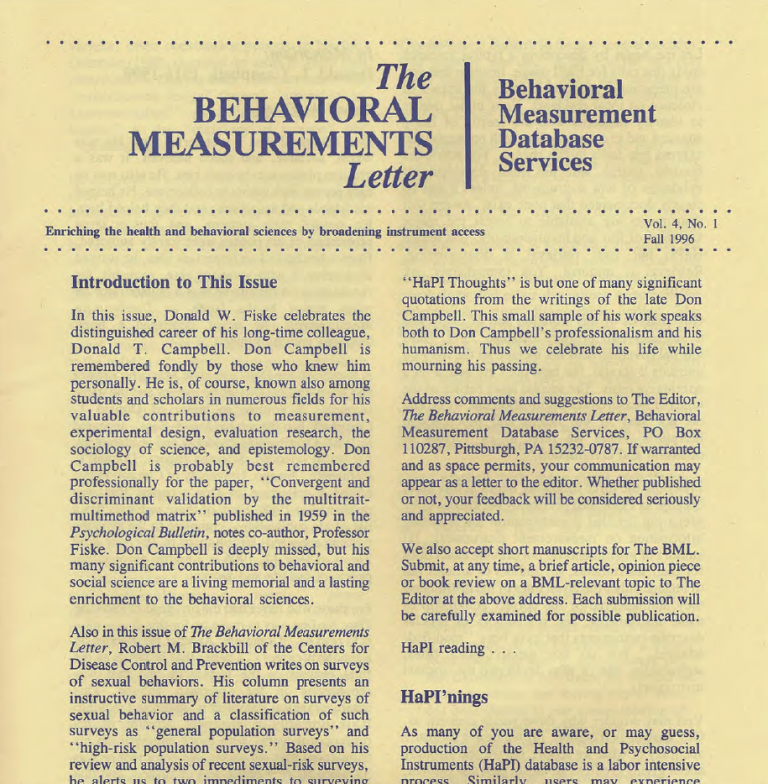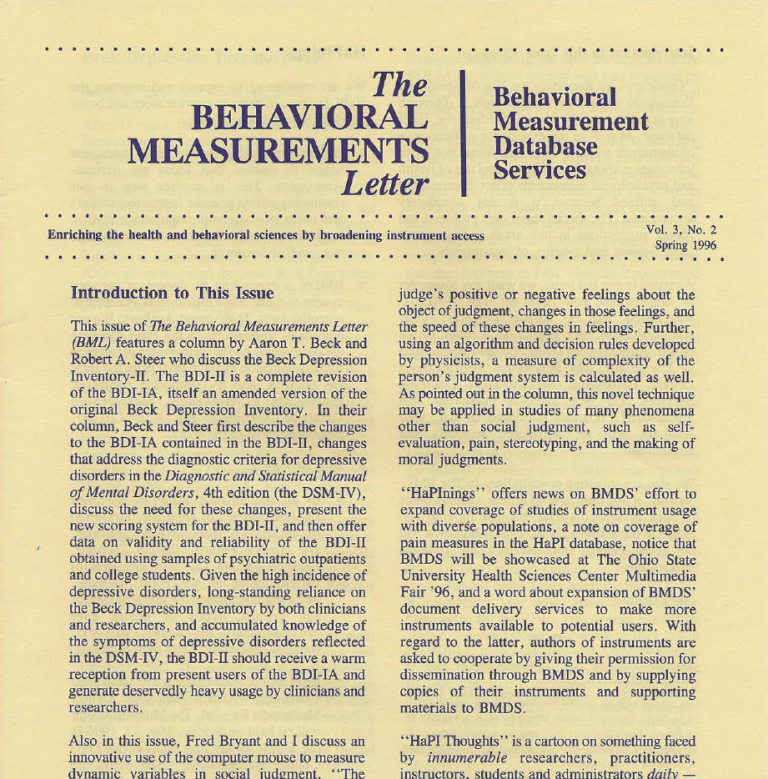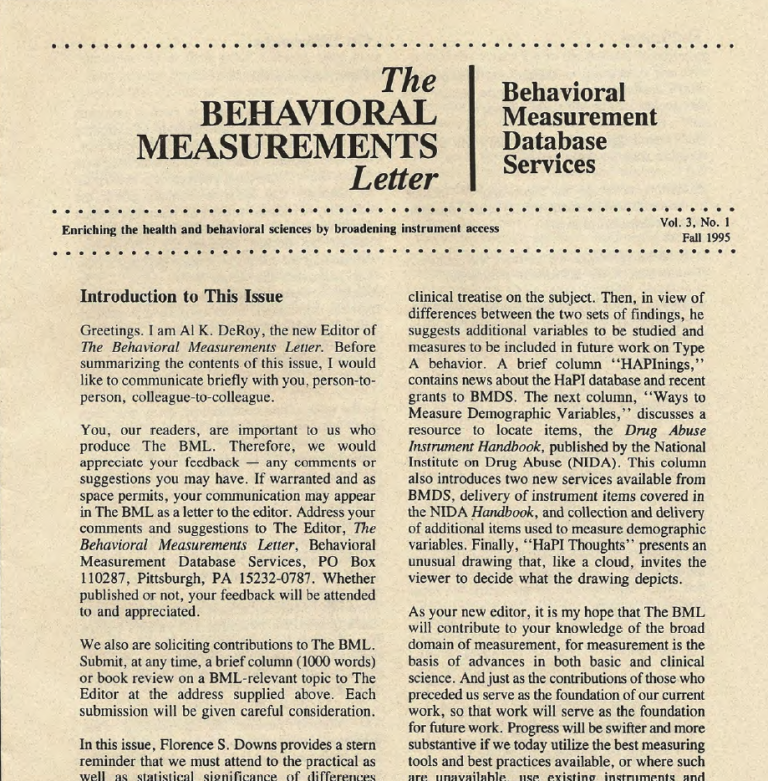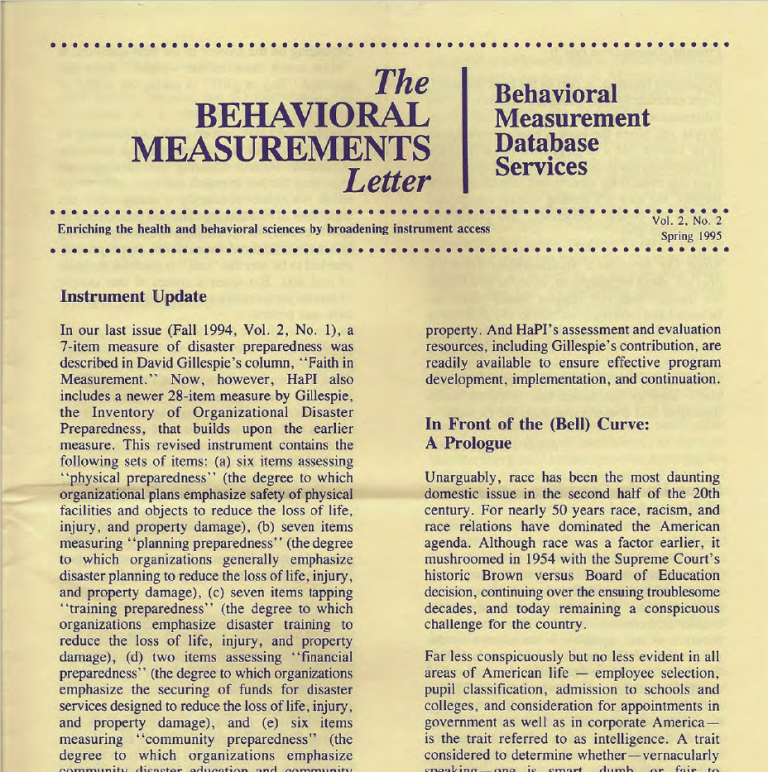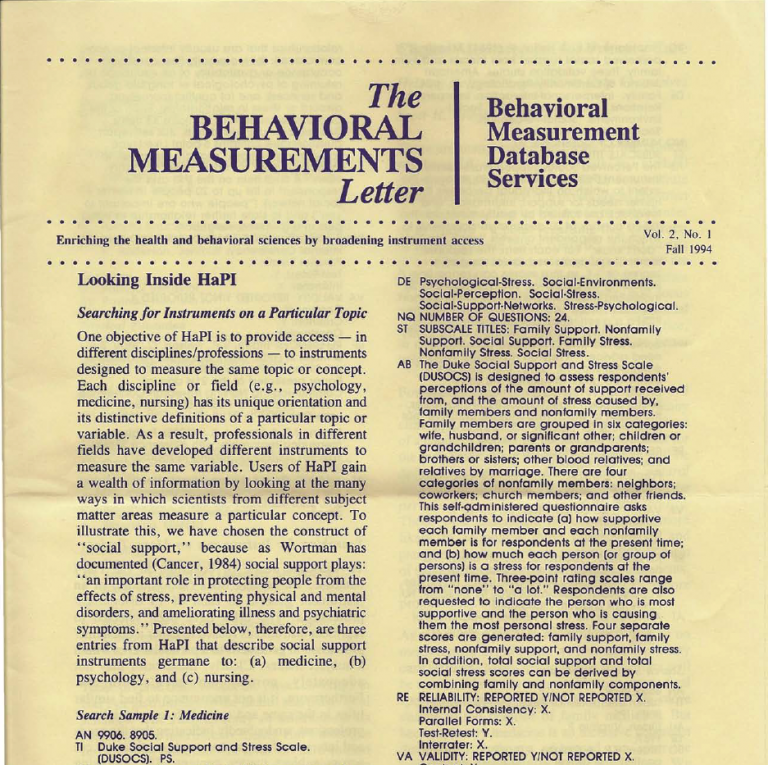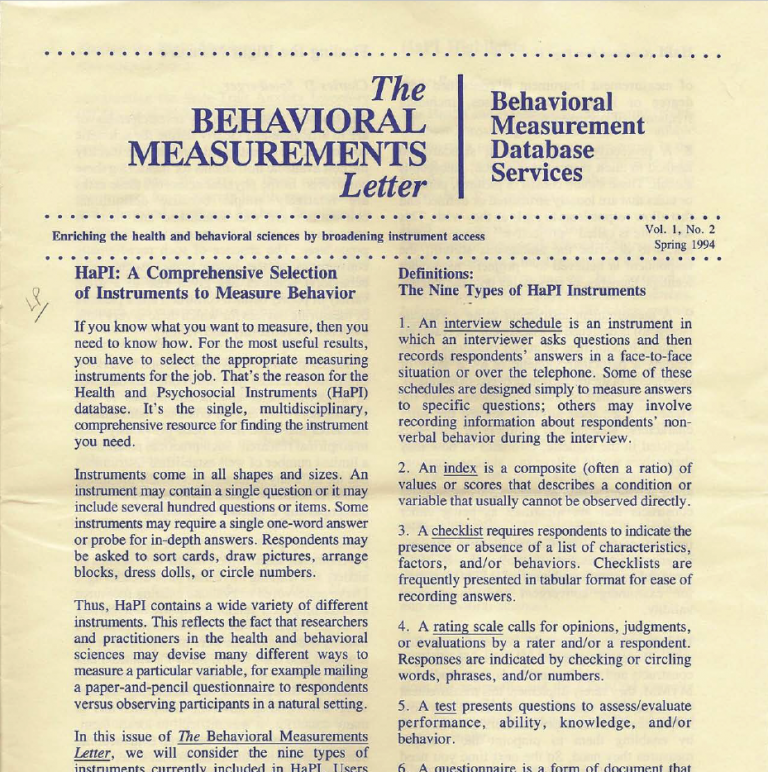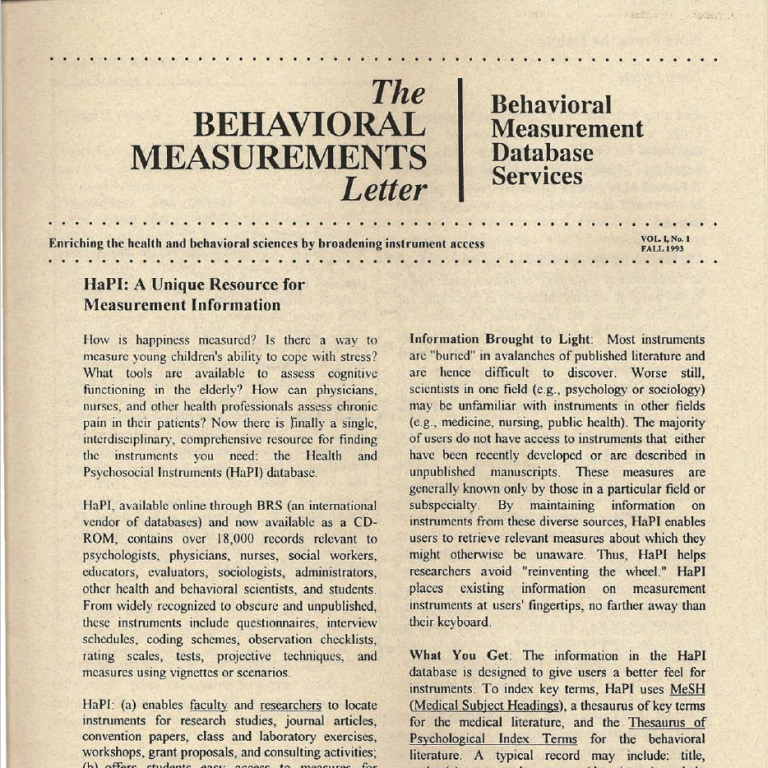Vol. 8, No. 1: Winter 2003
This issue of The Behavioral Measurement Letter includes three articles addressing very different topics; namely, “reactive insight” effects, impact of bullying, and the role of measurement in mountaineering. Although these articles appear at first glance to have little to do with one another, in fact they share a central focus on measurement. Indeed, the diversity of their subject matter underscores measurement’s amazing breadth of relevance.
In this issue of The Behavioral Measurement Letter, Eric Lang explores long-lasting ways in which answering self-report questions can change respondents’ thoughts, feelings, and behaviors. He refers to these influences as “reactive insight” effects. Lang notes both positive and negative consequences that may result from research participation. On the positive side, for example, research participation can make respondents see more strengths than weaknesses in their marriage; and completing open-ended questions about self-relevant issues can reveal new behavioral options, clarify personal priorities, and force one to confront problems that one might otherwise ignore.
On the negative side, however, answering self-report questions can also increase interpersonal conflict between partners, through increased communication. Although one could argue that this is not necessarily a negative outcome, it definitely raises ethical concerns about informed consent among research participants. Lang carefully considers the ramifications of “reactive insights” and urges researchers to pay closer attention to this important phenomenon. He also notes specific characteristics of research designs
(e.g., breadth of measurement coverage, issue relevance) and participants (e.g., introspective skill, motivation for self-discovery) that may increase the likelihood of reactive insight effects.
Also in this issue of The Behavioral Measurement Letter, Missy Fleming highlights the importance of measurement in understanding and solving the problem of bullying in the United States. She begins by defining bullying as a pattern of repeated verbal, nonverbal, or physical aggression against another person featuring a deliberate intent to harm the person without regard for the victim’s suffering. As she persuasively argues, bullying is a form of conduct disorder that poses special dangers in American school systems, Fleming insightfully discusses the widespread nature of bullying in our society, its prevalence among both boys and girls, its causes and consequences, and how researchers currently measure this problem behavior. She notes the challenge of constructing measurement instruments that are not only sensitive, valid, and reliable, but also nonthreatening, multifaceted, and age- and culture-appropriate. And she points out the need for more psychometric research to determine the conceptual overlap and uniqueness among alternative measures of bullying. Her article serves as a call for action among researchers, educators, and parents alike.
Finally, Fred Bryant’s article in this issue of The Behavioral Measurement Letter highlights the vital role that measurement plays in climbing the world’s highest mountains, the 8000-ineter peaks of the Himalaya. In the process, he drives home the crucial importance of measurement in any human endeavor in which it is important to make correct decisions. Just as Type 1 errors (i.e., concluding something is there when it actually is not) and Type I errors (i.e., concluding nothing is there when it actually is) matter in research. they matter even more in high-altitude mountaineering, where such mistakes are often
fatal.
Although few of us will ever try to reach the summit of Mount Everest, mountaineers and researchers alike share a common concern for accuracy in measurement. Bryant notes real-life cases from the mountaineering literature in which careful measurement enabled climbers to make the right choice, and other cases in which inaccurate measurement cost lives. Clearly, whether in the laboratory or on the heights, measurement matters.
Please address comments and suggestions to The Editor, The Behavioral Measurement Letter, Behavioral Measurement Database Services, PO Box 110287, Pittsburgh, PA 15232-0787.
We also accept short manuscripts for the BML. Submit, at any time, a brief article, opinion piece, or book review on a BML-relevant topic to The Editor at the above address. Each submission will be given careful consideration for possible publication.
HaPl reading…
Fred B. Bryant
Guest Editor
E-mail: bondshapi@aol.com
The Repercussions of Research Participation: Exploring Reactive Insight Effects
Eric L. Long
Each year, hundreds of social science and health surveys, involving tens of thousands of respondents, are conducted by researchers at universities, local and federal government agencies, health centers, foundations, businesses, nonprofit think tanks, and other organizations in an effort to advance basic and applied research across a number of broad domains, such as psychology, sociology, gerontology, and public health. The surveys are designed to make objective assessments of individuals and groups and, in the case of representative sample studies, to describe and predict important aspects of larger populations. Many social science and health surveys include assessments of personal and potentially stimulating topics such as sexuality, grief, courtship, family life, stress and coping, patenting, marital quality, personal adjustment, happiness, risk behavior, socialization, developmental issues, and mental health. Although generally under researched, there is a small but growing body of literature indicating that the experience of participating in surveys of this kind – particularly those what involve repeated assessments of sensitive topics over time – may inadvertently stimulate respondents to think about themselves, their lives, and their plans in new ways. The potential consequences of this type of reactive insight are two-fold. First, reactive insight may systematically bias survey assessments in certain areas and decrease their descriptive and predictive reliability for larger populations. Second, reactive insight may elicit nontrivial changes in respondents’ thoughts, feelings, or behaviors that are neither salutary nor short-lived. Consequently, improving research on reactive insight may contribute to several important areas. such as research design, measurement protocols, informed consent, the social psychological dynamics of personal reflection, and statistical error correction. The remainder of this paper briefly discusses the concept of reactive insight and a summary of recent results from an investigation of two five-wave panel studies.
Verified support for this work was provided by an NIMH grain (801-MNG605-01) to the author, while employed on Sociometrist Corporation. Concluding support for this work had been provided by the Prosocial Science Institute. The author gramofoily acknowledges research assistance provided by Dr. Harley Baker und Dr. Stephen Heane. This paper based, in pan, on a presenzion – Reactive Insight Hoffect on Participants in Two Panel Stunfire by the author at the American Psychological Association annual convection, August 26, 2201 (San Francisco, CA). Cortespadense should be directed to Eric L. Lang, PhD, Prosocial Science Instituted. 22 Loma Vista Place, Monterey, CA 93940, USA
(Eric@Praseelal.com).
Defining Reactive Insight
The term “reactive insight” was originally developed by the author to connect the concept to the established literature on reactive measurement error, and to focus attention on the experience of the research participant, especially as it relates to the social psychological dynamics of respondent introspection, considerations of personal relevance, self-concept, and their potentially enduring effects.
The more general concept of reactive measurement error is not new. One of the classic treatises of this concept appears in work by Webb, Campbell, Schwartz, and Sechrest (1966) who describe four classes of potential bias, i.e., threats to measurement validity, that are “produced by the respondent” as a reaction to research methods2. The four classes are: (a) awareness of being tested, (b) role selection, (c) response sets, and (d) measurement as a change agent (p. 13). The first three classes relate to a broad base of research showing that survey responses and research performance can be influenced by a variety of factors, such as respondents being self-conscious of research conditions, wording differences among questionnaire items, and cues regarding researchers’ expectations or desires. For example, there is over 60 years of literature investigating response set phenomena such as respondents’ propensities for agreeing with a statement, rather than disagreeing with its opposite (Sletto, 1937; Krosnick & Schuman, 1988). Furthermore, the “Hawthorne” studies describe a variety of ways that experimentally induced changes in subjects’ working conditions elicited altered behavior among workers who knew they were the subject of additional attention, although the methodology employed in those studies precluded precise causal interpretations (Lang, 1992). Hawthorne-type effects were subsequently clarified through studies of “demand characteristics” of participating in research (Lana, 1969). Overall, measurement reactivity based on awareness of being tested, role selection, and response sets appear to share the common features that the reactive effects are both short-lived, e.g., confined to the immediate aspects of the data collection, and substantively limited to areas of the original research questionnaire or protocol.
In contrast, the fourth class of reactivity, which Webb and colleagues (1966) termed “measurement as change agent,” comes closer to what should be defined as reactive insight, in that it relates to reactivity effects that produce long lasting change. Early studies of such change included studies of practice effects, e.g., enhanced performance due to repeated exposure to similar questions/tasks, and preamble effects, e.g., the creation of new and sustaining opinions among respondents who are asked for an opinion about a topic on which they previously had invested little thought (Cantril, 1944). More recently, Jagodzinski, Kuhnel, and Schmidt (1987) suggested that research participation may actually increase the importance of issues already salient to the respondent, i.e., “that the item content becomes more salient and central to many respondents because of the measurement process itself’ (p. 262). Eliminating from the definition simple practice effects that yield mostly superficial changes in test performance serves to further distinguish reactive insight as a unique, personal, and important concept. Thus, reactive insight effects can be defined as long lasting change in a respondent’s self-concept, attitudes, emotions, well-being, or behavioral tendencies as a result of research participation. It is not a requirement that the respondent is aware of participating in research, although survey respondents obviously have such awareness. Instead, growing evidence suggests that, for some participants and contexts, research participation causes directly or indirectly, e.g., through enhanced sensitivity to other social, environmental, or eliciting agents lasting changes as described above.
2Wochet sl. (1966) distinguished effects produced by the respondent from effects produced by the researcher, such as the class of bluses known as “interviewer effects.”
Prior Research on Reactive Insight
The “Boston Couples Study” Rubin and Mitchell (1976) interviewed several hundred unmarried couples, in one of the classic investigations of participation effects. Over a two-year period, study respondents (individually and as couples) completed questionnaires and interviews regarding communication processes. One year after the study, nearly half of all respondents reported (through closed and open-ended questions) that the study had an impact on their relationship. Typical open-ended responses included the following.
My relationship had been floundering at the time I first took part in the study, and because of some of the questions were really soul-searching, I re-examined where we were headed. She was much more serious than I was and I called it off. (p. 19)
The study forced us to think about our relation- ship in concrete terms (“Who is more open?” “Who is more involved in decision making?” etc.) and deal with it as an interpersonal relationship per se, rather than as merely another dating situation. (p. 19)
Rubin and Mitchell attributed such effects to processes of “definition,” e.g., having to describe one’s situation, and “disclosure,” e.g., the subsequent increase in communication between respondent pairs. The authors conclude:
By asking couples to scrutinize their relation- ships and by prompting them to discuss their relationships with one another, our study played a role in shaping these relationships. In some cases, our study served to strengthen a rela- tionship; in other cases, to facilitate its disso- lution. In the process, we unwittingly became couples counselors. (p. 17)
During the first stage of a follow-up to that study over 10 years later, Rubin noted evidence that the divorce rate among approximately 100 study couples who had gotten married was extremely low. Rubin suggests that “it seems quite possible that our study – in helping to cement some relationships and to shake up others, before marriage contributed to this result” (Rubin). 1986).
University of Texas at Austin Studies. Hughes and Surra (1997)’ conducted a three wave panel study of an initial sample of 120 (60 couples) over the course of a year. The study focused on premarital relationships using questionnaires and telephone interviews. Closed-ended and open-ended questions were also included to assess psychological and dyadic effects related to frequency of study participation, i.e., the total number of 11 possible telephone interviews completed. Analysis yielded several dimensions related to participation effects, such as “increased awareness of relationship processes,” effects on relationship activities,” “relationship defining influences.” and “relationship-evaluating influences.” The last influence was positively related to the number of interviews completed and to scores on a measure of relationship satisfaction.
In a similar longitudinal study of commitment among 232 heterosexual dating couples (n=464), Williams and Surra (1998) found that frequency of participation in up to nine study interviews as positively associated with relationship satisfaction for men but not for women. Furthermore, this effect was not dependent on prior levels of relationship satisfaction. However, further analysis and revised results from this study suggest that more frequent participation is associated with negative changes in relationship satisfaction or conflict for men and women in longer relationships (Surra & Williams, 2001, under review).
UCLA Studies. Bradbury (1994) conducted two studies of marital research that included closed-and open-ended assessments of reactive insight. Study 1 included 60 newly wed couples (n=120) interviewed twice over a six-month period, Study 2 included 47 couples (n=92) – in marriages that averaged 8 years – who participated in a laboratory study of dyadic communication. In study 1, Bradbury found that research participation resulted in respondents seeing more strengths than weaknesses in their marriage. Wives were more
This research was originally reported on the National Council on Family Relations conference Workshop on Theory Construction and Research Methodology, Baltimore, MD, November 11, 1993. Wives were likely than their husbands to report that the study affected the way they thought about their marriages. Furthermore, 72% of respondents reported a positive experience, 5% negative experience, 3% “mixed,” and 20% reported no effect of research participation. Of those that reported a positive effect. 67% emphasized intrapersonal changes, 30% focused on interpersonal changes, and 3% mentioned other effects, such as feelings of altruism. In Study 2, Bradbury assessed a methodological dimension and concluded that the dyadic communication research task tended to sample typical problem solving discussions, rather than creating artificial or overly troubling communications. In other words, the reactive insight effects were not the result of atypical discussions initiated by the research protocol.
University of Michigan Studies. Veroff and colleagues – in their 1992 Early Years of Marriage (EYM) Study – -report on the only known study of reactive insight that randomly assigned participants to either an experimental group that completed extensive questionnaires, interviews, and dyadic communication tasks over 4 waves of assessment, or to a control group that completed shortened versions of the interview and questionnaire, and were assessed less often. Experimental group participants showed greater reactive insight effects (mostly positive) than did the control group on measures of marital satisfaction and well-being. “These results suggest that better-adjusted marriages may have developed among study couples as a result of the more frequent and more involved interviewing” (p. 323). New EYM follow-up data collected by Veroff were analyzed by the author and summarized below.
Other Evidence. Several other researchers have also found support for the idea that panel studies involving respondent introspection may cause changes in well-being (Haight, 1992), attitudes (Sunford, 1965), and behaviors (e.g., Wilson & Dunn, 1986; Wilson, Dunn, Kraft, & Lisie, 1989), particularly when open-ended protocols are employed. In contrast, several studies of sexual attitudes have shown no effects on the sexual behavior of study participants over time (e.g., Halpern, Udry, & Suchindran, 1994). It may be that reactive insight effects are more likely to occur in studies with a high proportion of open-ended questions. Mishler (1986) describes the empowering quality of answering open-ended questions about self-relevant issues.
Through their narratives people may be moved beyond the text to the possibilities of action. That is, to be empowered is not only to speak in one’s own voice and to tell one’s own story, but to apply the understanding arrived at to action in accord with one’s own interests. (Mishler, 1986, p. 119)
Summary of Prior Studies. Extant research suggests that reactive insight: (a) derives primarily from participation in research on sensitive topics or ones with personal relevance to the respondent, (b) influences standard survey measures of attitudes, and marital satisfaction and well-being, (c) increases relative to the use of open-ended and narrative styles of interviews, (d) increases through multiple assessments, (e) produces effects that may endure up to a year and longer, and (f) has the potential to generate both positive and negative effects.
Given the hundreds of studies that have been conducted and will be conducted on personal topics such as marriage, stress and coping, courtship, family life, mental health, and adjustment, it will be important to better understand reactive insight effects and its consequences for research methodology and measurement reliability, as well as ethical issues regarding research participation.
The 2001 Study of Reactive Insight Effects
Reactive Insight effects were recently explored through analyses of new data from two panel studies: (a) the Role Conflict and Coping Among Women Professionals (Role Conflict) study, which began with a sample of women professionals (N=200, and 140 of their husbands) with preschool-age children; and (b) the Early Years of Marriage (EYM) study, which began with a representative sample of newly married couples (N=373) who had filed for marriage
Further detail on the study microscopy, results, and discussion appear in Lang (2002) licenses in Wayne County, Michigan. Both studies are particularly relevant to investigations of reactive insight in that they included:
- longitudinal assessments S waves of interviews over approximately 7-9 years;
- a rich variety of data on many of the following measures: satisfaction, stress, coping, health, functioning, and other conditions related to work, marriage, and parenting:
- information collected from respondents’ spouses on measures such as, marital satisfaction and perceptions of their partner’s satisfaction:
- specific closed-ended (both studies) and open-ended measures (Role Conflict study) of reactive insight;
- a longitudinal control group (BYM study) that received fewer and less intensive interviews than the main study group.
Select Findings and Speculation
When asked whether survey participation influenced feelings or behaviors related to their marriage, parenting, or work, 52% of Role Conflict study respondents answered “yes” and then gave open-ended elaborations, such as:
- I didn’t used to talk to myself to calm down. I started because you mentioned (in a question) about whether I talk to myself to
- It’s made me think about issues that came up in the surveys. It’s made my husband and me) talk about it, like our relationship. It’s brought up issues to discuss. For example, our expectations of each other. It made me realize that he does more than I thought he did to help out.
- I’ve begun to set limits on my job with the feeling that it was OK to do that.
- It’s brought to life how dissatisfied I can with my job,
- I never thought before about what I’d do I realized my career is very important to me and that I wouldn’t marry or have kids if I could do it over
- I’ve tried to look at the stress and see what I can delegate. I tend not to recognize stress and this [study] has made me more aware of it and now I take some action.
- Helps me prioritize work within my life. My children are much more important than work.
- I began walking and jogging for exercise.
- It’s kind of hard to bury your head in the sand and ignore problems when you have to answer these questions.
- I think this survey made [me] realize that you can’t be a super-mom and have or do it all. Compromises are needed between husband, wife, and kids to get things done.
- [Participating in the study convinced my husband to help more with the children.
- My husband and I separated in 1991 and divorced July 1992.
Across both studies (Role Conflict and EYM), results of content analyses and multivariate tests suggested a number of conclusions and future directions including:
- Self-reported reactive insight appraisals range from positive and beneficial to negative and stressful, but more often are positive.
- Reactive insight may increase communication between partners but, potentially, at the cost of increased interpersonal friction.
- Although the self-reported appraisals can be rich and moving, it is not yet clear how they related to changes in more objective assessments of satisfaction, well-being, and
- Using random assignment to a control group, which gets less frequent and less intense research exposure than a study group. appears to be more effective than self-reports of reactivity for isolating reactive insight
- Larger studies are needed–perhaps adding control groups to national sample studies to uncover the characteristics of respondents and research designs that cause or relate to reactive insight effects.
- The potentially negative effects of reactive insight need to be better understand so that researchers can design studies to minimize such effects, include appropriate informed consent agreements, and be prepared to assist distressed subjects.
- It may eventually be possible to reliably measure the effects of reactive insight on key dependent measures and then to statistically correct those measures to enhance the accuracy and representativeness of study
Although not entirely testable in the current studies, reactive insight appears to be a product of the following research design and participant factors:
Design features that may facilitate reactive insight:
- Research participation frequency
- Issue coverage (breadth of stimulating items)
- Narrative/open-ended response opportunities
- Issue relevance (as defined by the participant)
Participant features that may facilitate reactive insight:
- Introspective skill (ability to recognize and interpret self-relevant information)
- Motivation for discovering self-relevant information
Ethical Issues. With respect to ethical issues, of the 50%-80% of respondents (across studies previously described) who report effects of research participation, the majority (around 90%) report positive effects and show increases in measured satisfaction. Although only 3%-12% of respondents report negative effects, distress, or lower satisfaction scores, ethical guidelines for both the American Psychological Association (APA) and the American Sociological Association (ASA) clearly state that researchers must “take steps to implement protections for the rights and welfare of research participants and other persons affected by the research” (APA, 1992, 6.06d). Furthermore, “where research procedures result in undesirable consequences for the individual participant, the investigator has the responsibility to detect and remove or correct these consequences, including long-term effects” (APA, 1990, p. 395).
Because research on reactive insight suggests that certain study respondents may be subject to unintended emotional effects, there is an increased ethical burden or responsibility on the researcher to assess reactive insight effects and to have clinically appropriate resources available for respondents who may need them. In other words. when human subjects are involved, social science and health researchers should be prepared to deal with unintended sensitive disclosures and clinical reactions (for a fuller discussion, see Bersoff and Bersoff, 2000).
Measurement Issues. With respect to research methodology and measurement, it is a significant scientific problem when the act of measurement distorts the validity and representativeness of one or more assessed values. Bradbury (194) notes, “studies are needed to identify which individuals, which marriages, and which research procedures are associated with negative reactions to participation” (p. 199). Such research should build on the wealth of scientific evidence available on cognitive and contextual effects on respondents’ answers (e.g. Schwartz, 1999, and Tourangeau, Rips, & Rasinski, 2000). Thus, to improve social science research, these issues will require a detailed empirical examination of a full range of individual, situational, and methodological aspects of reactive insight.
Next Step. More communication is needed among researchers to discuss reactive insight effects that may be occurring in their studies, and to design better methods to uncover and address reactive insight effects in the future. Readers who are interested in this area are invited to communicate directly with the author at Eric@Prosocial.com.
References
American Psychological Association, (1990). Bilical principles of physiologists. (Amended June 2, 1989), American Psychologist, 45, 390-395,
American Psychological Association. (1992). Bilical principles of physiologists and code of conduct (Effective date December 1. 1992.). 6.06(d) Planning Research.
(batp://www.apa.org/ethicsfcode.html.)
Bersoft, D.M., & Bersoff, D.N. (3000). Ethical issues in the collection of self-report date. la A.A. Stone et. al. (Eds.) The science of self-report. Mahwah, NJ: Erlbaum,
Bradbum, NM, (1969). The structure of psychological well-being. Chicago, H. Aldine.
Bradbury, TN. (1994). Unintended effects of marital research on marital relationships. Journal of Family Psychology & 187-201,
Cantril. 11. (1944). Gauging public opinion. Princeton, NJ: Princeton University Press,
General Accounting Office (May, 2001). Fuman subjects research: BIS takes steps to strengthen protections, but concerns remain. (GAQ-01-775T).
Haight. B.K. (1992). Long-term effects of a structured life review process. Journal of Gerontology, 47, 312-315.
Halpern, CT, Udry, JR., & Suchindran, C. (1994). Effects of repeated questionnaire administration in longitudinal studies of adolescent males’ sexual behavior. Archives of Sexual Behavior, 23,41-57.
Hughes. D., & Surra, CA. (1997). The reported influence of research participation in premarital relationships. Unpublished manuscript. The University of Texas at Austin.
Jagodzinski, W., Kuhnel. S.M., & Schimidt, P. (1987). Is there a “Socratic effect” in nonexperimental panel studies?. Sociological Methods and Research 15, 259-302.
Krosnick, J.K.. & Schuman, I. (1988). Anitade intensity, importance, and certainty and susceptibility to response effects. Journal of Personality and Social Psychology, 54, 949-952.
Lang, B… (2002). Reactive insight effects of research participation. Manuscript in progress.
Lang, L. (1992). The Hawthome Effect. In E.F. Borgatta & M.L. Borgata (Eds.) Encyclopedia of sociology New York: Macmillan.
Lang. E.L. (1988). Rule conflict and work family spillover: Comparing academic and nonacademic multiple-role women. Dissertation Abstracts International. 49, 4912-B. University Microfilms International No. 89-07077.
Mishler, E.G. (1986). Research interviewing: Context and narrative. Cambridge, MA: Harvard University Press, p. 119.
Ome, M.T. (1969). Demand characteristics and the concept of quasi-controls. In R, Rosenhai & R. Rosnow (Eds.) Artifact in behavioral research. New York: Academic Press.
Rubín, Z., & Mitchell, C. (1976). Couples research as couples counseling: Some unintended effects of studying close relationships. American Psychologist, 31, 17-25.
Rubin. Z. (August 4, 1986). Personal communication.
Sanford, N. (1985). Research and policy in higher education. In N. Sanford (Ed.), The American college: A psychological and social interpretation of de higher learning. New York: Wiley.
Schwartz, N. (1999). Self-reports: How the questions shape the answers. American Psychologist, $4, 93-10s.
Sletto, R.F. (1937). A construction of personality scales by the criterion of internal consistency. Hanover, NIE: Sociologien Press,
Surra, C.A., & Williams, K. (2001, under review). Does participation in a longitudinal study have negative effects on personal relationships? Ethical implications for human subjects.
Tourangeau. R., Rips, L., & Rasinski, K. (2000). The psychology of survey response. Cambridge University Press.
Veroff, J.. Hatchell, S., & Douvan, E. (1992). Consequences of participating in a longitudinal study of marriage. Public Opinion Quarterly 56, 315-327.
Webb, B.J., Campbell, D.T., Schwartz. R.D., & Seckrest, L. (1966). Unobtrusive measures: Noureactive research in the social sciences. Chicago: Rand McNally.
Williams, K., & Surra. C.A. (August, 1998). The effects of research participation on the relationship satisfaction of premarital parmas. Paper presented at the meeting of the American Sociological Association, San Francisco, CA,
Wilson. T.D., & Dunn. D.S. (1986). Effects of introspection on attitude-behavior consistency: Analyzing reasons versos focusing on feelings. Journal of Experimental Social Psychology, 22, 249-263.
Wilson. T.D., Dunn, D.S., Krafi. D., & Lisle, D.J. (1989). Introspection, antinode change, and attitude-behavior consistency: The disruptive effects of explaining why we feel the way we do. In L. Berkowitz (Ed.) Advances in Experimental Social Psychology. 22, 287-343. Orlando, FL Academic Press.
Eric Lang is the President of the Prosocial Science Institute and a Senior Scientist with Northrop Grumman Corporation. The Prosocial Science Institute conducts basic and applied research, product development, and consulting for the advancement of psychological science, health, and human potential. Dr. Lang has worked on national projects related to education and health at the American Institutes for Research (1988-1991), and then as Principal Research Scientist and Division Director for Research Products and Services at Sociometrics Corporation (1991-1999), where he developed research data archives, designed social science tools for the Internet, and investigated methodological effects. In addition to his work on reactive insight effects, Dr. Lang’s research interests include cooperation and helping. research archives, personnel security, and social science methodology, Individuals with similar interests are encouraged to contact him at Eric@Prosocial.com.
Read additional articles from this newsletter:
What’s the Big Deal About Bullying?
The Vital Importance of Measurement in High-Altitude Mountaineering
8-1-winter-2003

